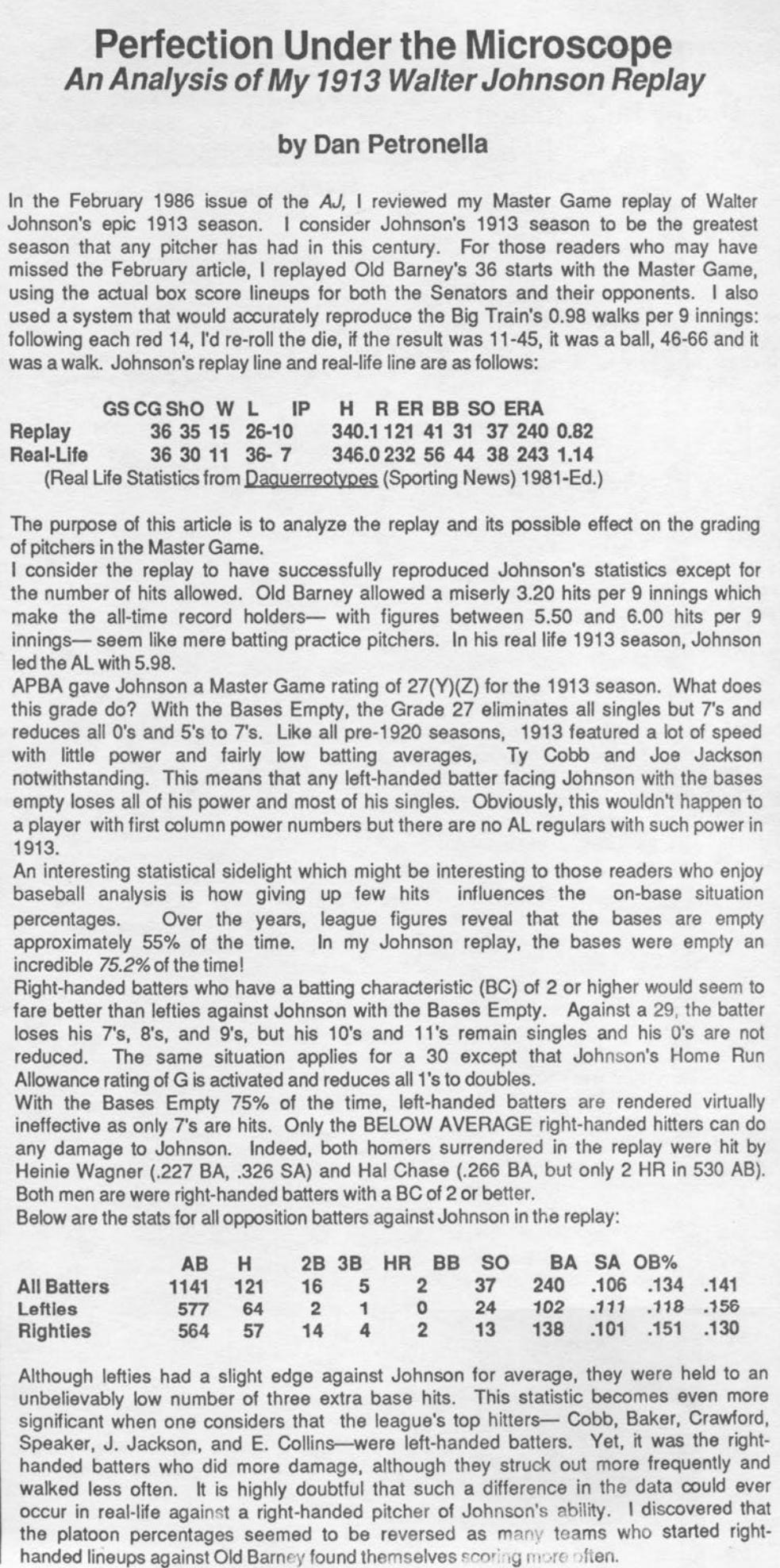Making Your Replay Engaging
You never quite know where a project is going to take you.
I took some time out the other day to reread the first issue of The APBA Journal. As I’ve mentioned before (though it’s been a while), the glory days of The APBA Journal — the Howard Ahlskog 1985-1993 era in particular — has been a major influence on me, both on my replaying habits and on my decision to start projects like this one.
Of course, the fascinating thing about The APBA Journal is that its initial format probably wouldn’t have attracted many readers.
If I remember my APBA Journal lore correctly, it was started in late summer 1967 by Leonard and Ronald Gaydos, two brothers who were fascinated with APBA baseball. The APBA Journal was actually not their first publication: they had previously created a similar newsletter for their league, the National Shoreview APBA Baseball Congress (NSABC for short). I’m not sure that any of those pre-APBA Journal newsletters survived. What I understand, though, is that they actually had a small readership in those early days, and were already on the search for other APBA players.
The most interesting thing about the first issue of The APBA Journal is that it was focused almost exclusively on league play:
The first issue features reports on four different leagues, none of which are technically “draft” leagues, and yet none of which follow the standard “play through the real schedule” replay approach. These are leagues that were basically pieced together by interested fans of the game. For example, one league features an 8 team National League replay played among 8 managers who were presumably playing each game face to face.
But the fascinating part about all of this is how much The APBA Journal wound up changing over the years.
Led in part by editorial decision and in part by the things readers were interested in, The APBA Journal eventually focused more on game innovations, scouting reports, season reviews, company politics, and, eventually, technological developments. Replay reports remained a feature, though the ease of automatic computer replays meant that the editors had to be somewhat picky about what counted as a “proper” replay for publication. And draft leagues — the thing that the publication was supposed to focus on from the beginning — wound up fading into obscurity.
Take, for example, this somewhat lenghty letter to the editor from the March 1991 issue:
Editor Howard Ahlskog wasn’t exactly known for being sparse with words, and wrote this extensive reply:
Yeah, Howard was known for his love of writing. But what Howard didn’t say here — and what he should’ve said — is that reporting only on replays really isn’t as engaging as you think.
In fact, Howard might have mentioned The APBA Replay Journal, a publication that APBALone editor Daryl Hollis tried to set up in the mid-1980s:
It seems that The APBA Replay Journal actually might have seen at least one issue:
Hollis, however, ended up disappearing completely from the pages of The APBA Journal not long after this. I’m not sure if there were ever any actual issues of The APBA Replay Journal; if you happen to know anything about this rumored publication, please let me know in the comments.
The point here, though, is engagement. The sad truth is that the replay you’re working so hard on — the one that has you going through old newspapers and magazines, the one that gets you listening to old baseball radio broadcasts and watching old film clips, the one that has you listening to popular music from that period of time — that replay is probably not going to attract a lot of readers.
I’ve learned that lesson myself — and longtime readers of The Baseball Replay Journal have probably noticed the shift in tone and focus over the years.
That’s not to say that there’s anything wrong with reporting replay statistics, or even interesting things that happen in individual games. Actually, I think we need more detailed reporting like that, not less.
However — you’ve got to keep your audience in mind. You want to report something that is engaging and interesting. You want to tell a story with your report, a story that might be interesting to somebody even if they haven’t put in all the research and time and effort that you clearly have.
Ask yourself this question. Which is more engaging — this:

Or this:
The second one is more interesting, right? Instead of just being a collection of stats, it includes a commentary on the game itself. It’s not necessarily a guide on how to play the game, but, rather, a commentary on what the APBA Master Game did well and didn’t do well.
That’s what engagement is.















As someone who primarily plays SOM, I've always felt the APBA community has more interesting replay, history, and game content than SOM. Strat certainly has some, but it was reading those APBA discussions on Delphi that led me to pick up the game.
I thought your take on this was spot on. If anything, I think it’s even more true today than it was back in 1991 — the general interest in someone else’s replay just isn’t there like it used to be.
In the six issues I’ve done of The Sports Games Journal over the past year and a half, I’ve gotten almost no feedback or discussion when it comes to the replay material. I still include a little at the end, mostly for nostalgia — because honestly, a sports replay publication without any replays just feels off.
Do some people still read the ones I include or follow other replays elsewhere? Sure. But do they resonate? I’d say no, not really.